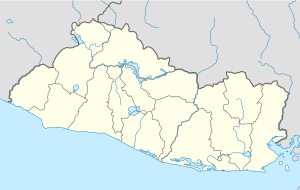San Juan Opico | |
|---|---|
Municipality | |
 San Juan Evangelista Parochial Church | |
| Coordinates: 13°53′N89°21′W / 13.883°N 89.350°W | |
| Country | El Salvador |
| Department | La Libertad |
| Area | |
• Total | 84 sq mi (218 km2) |
| Elevation | 1,614 ft (492 m) |
| Population (2007) | |
• Total | 74,280 |
San Juan Opico (or Opico) is a municipality in the La Libertad department of El Salvador.
Contents
It is located 42 kilometers from San Salvador, capital of the country. The municipality has an area of 218 km2 and a population of 74,280 inhabitants; according to the 2007 census it is ranked No. 13 in population.
Within its territory are pre-Columbian archaeological sites like Joya de Cerén and San Andrés and a church built in the colonial era.

